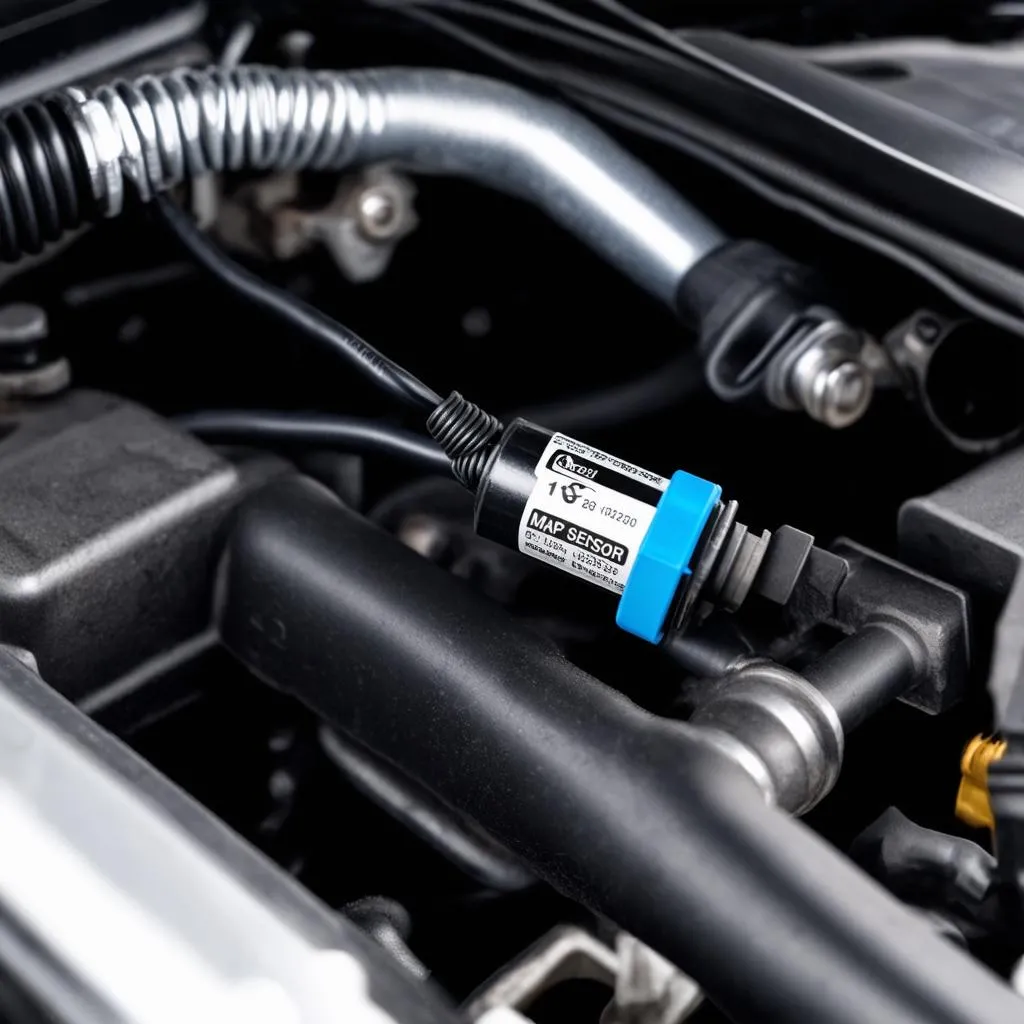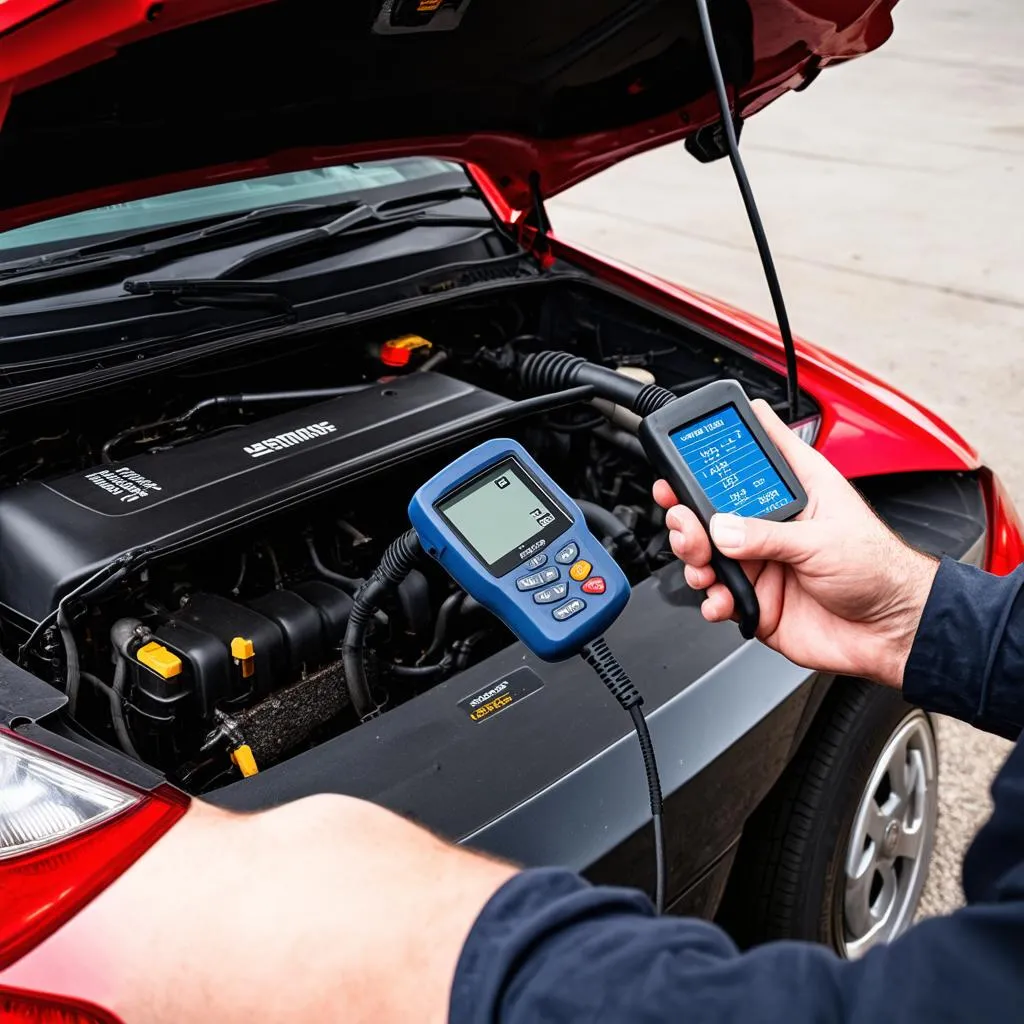You’re cruising down the highway, enjoying the open road, when suddenly the dreaded “check engine” light illuminates on your dashboard. You pull over, heart sinking, wondering what’s wrong with your precious European car. It’s a familiar feeling for many car owners, and it’s often accompanied by a sense of dread, especially when you see codes like “P0106” pop up on your diagnostic scanner.
What Does P0106 Code Mean?
The P0106 code is a diagnostic trouble code (DTC) related to the Manifold Absolute Pressure (MAP) sensor in your car’s engine. This sensor is crucial for the engine control unit (ECU) to accurately calculate the amount of fuel and air needed for optimal combustion.
Think of it like this: The MAP sensor is the engine’s “breath sensor”, informing the ECU about the pressure within the intake manifold, which is a critical factor in determining how much air the engine is taking in.
Why Is P0106 Code Important?
The P0106 code signifies a problem with the MAP sensor, which can have a significant impact on your car’s performance.
Here’s why it’s crucial to address this issue:
-
Fuel Efficiency: An inaccurate MAP sensor reading can lead to over- or under-fueling, negatively affecting fuel efficiency. This means you’ll be burning more gas than you should, costing you money at the pump.
-
Engine Performance: A faulty MAP sensor can cause rough idling, engine hesitation, stalling, or even misfires, affecting your car’s overall driving experience.
-
Emissions: A malfunctioning MAP sensor can disrupt the air-fuel mixture, potentially leading to increased emissions and a failure to pass smog checks.
Remember, a car’s performance is a delicate balance of many systems working together. The MAP sensor plays a critical role in this dance, and a problem with this sensor can disrupt the entire system.
Causes of P0106 Code
Several factors can contribute to the P0106 code. Here are some of the most common culprits:
1. Faulty MAP Sensor:
This is the most likely culprit behind the P0106 code. A damaged or defective MAP sensor can’t provide accurate pressure readings to the ECU.
2. Vacuum Leaks:
Cracks or holes in the intake manifold, vacuum hoses, or other related components can cause inaccurate MAP sensor readings.
3. Electrical Problems:
Problems with the wiring harness, connectors, or even the ECU itself can prevent the MAP sensor from communicating properly.
4. Altitude Changes:
When your car goes from lower to higher altitudes, the air pressure changes, which can affect the MAP sensor’s readings. However, modern ECUs are designed to compensate for these changes, so altitude shouldn’t be the sole cause of the P0106 code.
Troubleshooting P0106 Code
Before you start replacing parts, it’s essential to troubleshoot the problem properly. Remember, a hasty diagnosis can lead to unnecessary repairs and expense.
1. Inspect the MAP Sensor:
- Location: The MAP sensor is typically located on the intake manifold, usually near the throttle body.
- Visual Inspection: Check the sensor for any visible damage, cracks, or loose connections.
- Cleaning: Clean the sensor with a contact cleaner, being careful not to damage the sensor itself.
2. Check for Vacuum Leaks:
- Visual Inspection: Carefully inspect the intake manifold, vacuum hoses, and other related components for any cracks, holes, or loose connections.
- Smoke Test: A smoke test can help identify any vacuum leaks.
3. Electrical Testing:
- Wiring Harness: Check the wiring harness for any broken wires, loose connections, or corrosion.
- Connectors: Inspect the connectors for any damage, corrosion, or loose connections.
4. Diagnostic Scanner:
A diagnostic scanner can provide more detailed information about the P0106 code, including the specific conditions under which the code was triggered.
Resolving P0106 Code
1. Replacing the MAP Sensor:
If you’ve determined that the MAP sensor is faulty, it’s time to replace it. Make sure you purchase a compatible sensor for your specific vehicle model and year.
2. Repairing Vacuum Leaks:
If you’ve identified a vacuum leak, it’s important to repair it promptly to prevent further damage to your engine.
3. Addressing Electrical Problems:
Repairing any electrical problems, such as broken wires or loose connectors, is crucial to ensure proper communication between the MAP sensor and the ECU.
What If You’re Still Getting P0106 Code?
If you’ve tried all of the above troubleshooting steps and you’re still getting the P0106 code, it’s time to seek professional help. A qualified mechanic can perform a more in-depth diagnosis and identify the root cause of the problem.
Remember, don’t dismiss the importance of expert advice. A mechanic can ensure that your car is properly repaired and running smoothly.
Frequently Asked Questions
1. Can I drive with the P0106 code?
It’s generally not advisable to drive with the P0106 code for an extended period. A faulty MAP sensor can affect fuel efficiency, engine performance, and emissions, potentially leading to further damage.
2. Is it safe to replace the MAP sensor myself?
Replacing the MAP sensor yourself is possible for some, but it requires a basic understanding of automotive mechanics. If you’re not comfortable with DIY auto repairs, it’s best to leave it to a professional mechanic.
3. How much does it cost to fix the P0106 code?
The cost of repairing the P0106 code can vary depending on the cause and the complexity of the repair. Replacing a MAP sensor can range from $50 to $200, while repairing vacuum leaks or electrical problems can be more involved and costly.
4. What are some related OBD codes?
Related OBD codes that may indicate issues with the intake manifold, vacuum leaks, or electrical problems include P0101, P0103, P0107, and P0108.
5. Can the P0106 code be caused by a bad fuel pump?
While a faulty fuel pump can lead to various engine problems, it’s not directly related to the P0106 code, which is specifically related to the MAP sensor.
Conclusion
The P0106 code might seem daunting, but with proper understanding and troubleshooting, you can address it effectively. Remember to consult a qualified mechanic if you need help diagnosing or repairing the issue.
Don’t let this code hold you back from enjoying your European car. With the right knowledge and resources, you can get back on the road and feel confident knowing your car is running smoothly again.
 MAP Sensor
MAP Sensor
 Diagnostic Scanner
Diagnostic Scanner
For expert assistance in diagnosing and resolving the P0106 code, contact us on WhatsApp: +84767531508